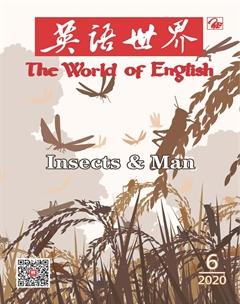Locust Plague: One of the Worst Agricultural Disasters 蝗灾
中国国际电视台


The locust outbreak is affecting large parts of South Asia and the African continents. Massive swarms of locusts have been destroying farmland and threatening millions of lives. Even troops and planes have been mobilized in the Horn of Africa region to fight the most serious plague in decades.
How can an insect with an average mass of 2 grams be so destructive?
Locust plagues often come with serious drought. The insect prefers to lay eggs in dry and loose soil with a lower moisture content. During dry seasons, the groundwater level falls offering more loose soil for the locusts to reproduce. Nearly 5,000 clusters of eggs can be found within a square meter, with more than 100 eggs per cluster.
The reproduction rate of some species is two to five times per year, which adds to the enormous figure. On the dry and sparse grassland, more locusts mean less living space. When the population reaches a certain density under suitable conditions, serotonin in their brains drives them from being solitary to gregarious. They “migrate” together to find new food sources in more moist areas, thus causing an outbreak.
In addition, global warming means warmer winters, therefore more hibernating eggs can survive and hatch in the spring, raising the possibility of the plague next year.
The desert locust is one of the most dangerous of the species. It is the main culprit of the plague that has hit eastern Africa.
Desert locusts can travel between 100 and 200 kilometers per day. A single swarm can cover up to 1,200 square kilometers and can contain between 40 and 80 million locusts per square kilometer.
How many times have humans suffered from locust plagues?
In history, locust plagues have been one of the three worst agricultural natural disasters, alongside flooding and drought.
During the last two millennia, more than 170 outbreaks have been recorded in China. Statistics from 2003 to 2016 show that the land hit by locust outbreaks reached 286 million hectares in China.
In 2004, northern and western Africa experienced the largest infestation of locusts in more than 15 years. It cost 400 million dollars to fight against the plague, and the harvest losses were worth almost 2.5 billion dollars.
Late March 2013, nearly 50 percent of Madagascar was infested by locusts, with each swarm consisting of more than one billion bugs.
Is there no way to stop the locusts?
At present, the primary method of controlling locust infestations is with insecticides sprayed from the ground or the air. That being said, in some less economically developed areas insecticides are unaffordable, let alone the machines and planes needed to spread them.
But there are also biological pest control measures. The locust has natural enemies such as predatory wasps and flies, birds and reptiles.
Every May, swarms of locusts hit northwestern Chinas Xinjiang Uygur Autonomous Region.
In 2019, nearly 200,000 rosy starlings stopped over Hami City in Xinjiang. The birds protected 54 million kilograms of grass from locusts, saving herdsmen 1.6 million yuan and at least 720,000 yuan for buying pesticides.
This biocontrol method has proved effective and requires less human intervention.
Are locusts of no use at all?
The term “locust” is the name given to certain species of short-horned grasshoppers in their swarming phase. They are convenient for use in research and the study of zoology. Like the fruit fly, it is a suitable school laboratory animal.
Locusts are edible. They are considered a delicacy in many African, Middle Eastern and Asian countries.
China has yet to come out of the shadow of locust plagues, according to Kang Le, a research fellow of the Institute of Zoology, Chinese Academy of Sciences. Locusts destroy crops at the estuary of the Yellow River, and the grasslands in Xinjiang and Inner Mongolia autonomous regions.
But it is wrong to overkill them. The overuse of insecticides may control the bug situation in an area for now, but it takes longer for the damaged environment to recuperate. Also, the insect always has its rightful place in the food chain and in the ecosystem.
蝗灾暴发正影响着南亚大部和非洲大陆大部分地区。大批蝗虫摧毁农田,数百万人生计遭受威胁。“非洲之角”地区甚至调派了军队和飞机对抗数十年来最严重的灾情。
一只平均重量只有2克的昆虫为何具有如此强大的破坏力?
蝗灾常常伴随旱灾而来。蝗虫喜在含水量较低、干燥疏松的土壤中产卵。在旱季,地下水位下降,土质更加疏松,利于蝗虫繁殖。1平方米土壤中能发现近5000个卵块,每个卵块有100多个卵粒。
某些种类的蝗虫每年可繁殖二到五代,致使其数量大增。在干燥稀疏的草原地区,蝗虫数量越多,意味着其生存空间越小。在适当条件下,当蝗虫密度达到一定程度时,蝗虫大脑中的血清素会促使其从散居型转变为群居型。它们会一起向更潮湿的地区“移民”,寻找新的食源,从而引发蝗灾。
此外,全球变暖带来暖冬,因此更多越冬虫卵得以存活并在春季孵化,增加了来年蝗灾暴发的可能性。
沙漠蝗虫是最危险的蝗虫之一,是东非地区蝗灾的罪魁祸首。
沙漠蝗虫每天可飞行100至200公里。单一虫群可覆盖1200平方公里,每平方公里的蝗虫数量可达4000万至8000万只。
人类迄今遭受过几次蝗灾?
历史上,蝗灾与水灾和旱灾并称三大农业自然灾害。
过去2000年中,中国共记载了170余次蝗灾。2003年至2016年统计数据显示,中国蝗灾发生面积达2.86亿公顷。
2004年,非洲北部和西部地区遭遇了至少15年来最大的一次蝗灾,抗灾费用高达4亿美元,灾情造成价值近25亿美元的收成损失。
2013年3月末,马达加斯加近50%的地区遭受蝗灾,每个虫群的蝗虫数量超过10亿。
没有办法阻止蝗灾暴发吗?
目前,防治蝗灾的主要方法是从地面或空中喷洒杀虫剂。话虽如此,但一些经济欠发达地区连杀虫剂都买不起,更不要说用来喷洒杀虫剂的设备和飞机了。
不过,还有生物治蝗的方法。蝗虫有很多天敌,例如掠食性黄蜂、蝇类、鸟类和爬行动物。
每年5月,会有大批蝗虫侵袭中国西北部的新疆维吾尔自治区。
2019年,近20万只粉红椋鸟迁徙至新疆哈密市。这些椋鸟保护了5400万公斤牧草免受蝗虫侵害,使牧民避免了160万元的经济损失,还省下了至少72万元购买杀虫剂的费用。
实践证明,这一生物防治方法颇为有效,且不需要多少人工干预。
蝗虫一无是处吗?
“蝗虫”这一术语是某些短角蝗科动物在集群期的统称,便于调研和动物学研究时使用。像果蝇一样,蝗虫适用于学校实验。
蝗虫可以食用,是非洲、中东和亚洲许多国家餐桌上的美味。
中国科学院动物研究所研究员康乐称,中国尚未摆脱蝗灾阴影。蝗虫会破坏黄河入海口的农作物以及新疆维吾尔自治区和内蒙古自治区的草原。
然而,过度杀灭蝗虫并不可取。过量使用杀虫剂或许当下可以控制某个地区的蝗灾,但会导致该地区环境受损,恢復期更长。另外,食物链和生态系统中始终应有蝗虫的一席之地。 □
(译者单位:复旦大学)

